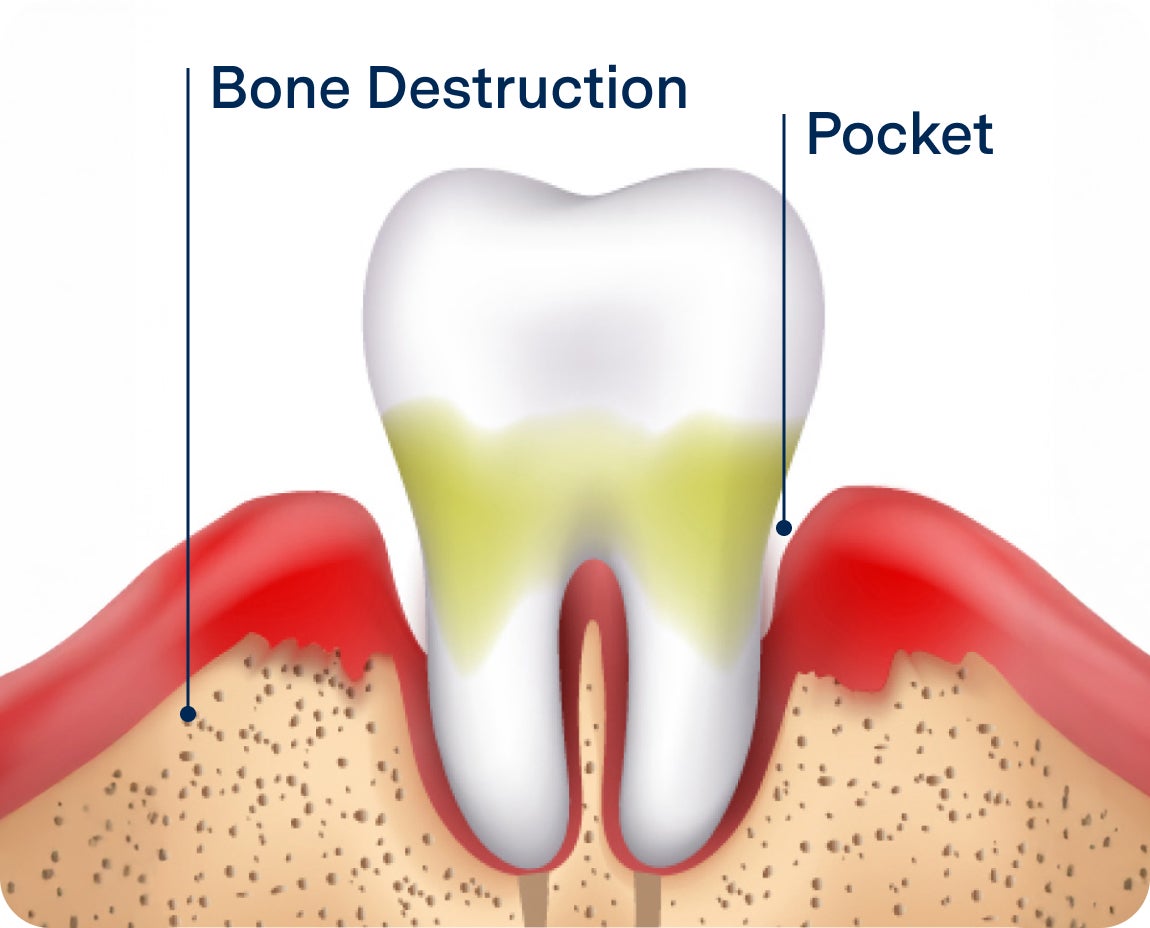Last updated 08.20.2025
Periodontal abscess: signs, causes, and treatment
A periodontal abscess causes pain, swelling, and pus. Learn about the symptoms, causes, and treatments.

A periodontal abscess may start with a nagging toothache or a sore spot near the gumline—but what’s happening underneath can be much more serious. This type of dental infection can lead to pain, swelling, pus, and if left untreated, bone loss or tooth loss.
But here’s the good news: with prompt care, a periodontal abscess is treatable. And at Aspen Dental, our experienced care teams are trained to spot the signs early, treat the infection and help you protect your long-term oral health.
In this guide, we’ll walk through the causes of a periodontal abscess, common symptoms to watch for, and the treatment options that can help restore your smile and peace of mind. If you believe you have a periodontal abscess, schedule an appointment at Aspen Dental today.
What is a periodontal abscess?
A periodontal abscess—also called a gum abscess—is a pocket of pus that forms in the soft tissue of the gums. It’s typically caused by a bacterial infection, often the result of gum disease or an injury that allows bacteria to enter the space between the teeth and gums. The infection leads to inflammation, swelling and a buildup of pus, which can cause pressure and pain. If left untreated, a periodontal abscess can damage nearby bone and tissue and may even lead to more widespread infection.
It’s important to treat gum abscesses as early as possible to avoid more serious complications—and to prevent long-term harm to your teeth and gums.

What causes a periodontal abscess?
The most common cause of a periodontal abscess is untreated gum disease (also known as periodontitis). As gum disease progresses, it creates deeper pockets between the teeth and gums, where bacteria can collect and multiply.
But other factors can increase your risk, too:
Bruxism (teeth grinding) creates pressure that can damage the gumline and open the door for bacteria
Injury or trauma, such as a cracked tooth or gum injury that exposes the tissue
Poor oral hygiene increases plaque buildup and makes it easier for infections to start
Smoking or tobacco use slows healing and weakens gum tissue
Underlying health issues, such as diabetes or autoimmune conditions that affect healing
Previous dental work. Sometimes, food or debris can get trapped in spaces near a filling or crown
In many cases, the infection starts small but can progress quickly without proper care.
Signs and symptoms of a periodontal abscess
So how do you know if you’re dealing with a periodontal abscess? Here are the most common symptoms:
Throbbing or sharp toothache
This is often the first sign. The pain may feel intense and may get worse when you bite down or chew.
Swelling or tenderness near the gums
You may notice puffiness or redness around a tooth or along the gumline.
A visible bump or pimple on the gums
A gum abscess often looks like a small bump or blister. In some cases, pus may be visible or may drain into the mouth.
Bad taste in your mouth
That bitter, metallic taste may be caused by leaking pus or the presence of bacteria in the mouth.
Bad breath (halitosis)
Because of the infection, brushing and flossing may not fully resolve the odor, and may lead to halitosis.
Swollen lymph nodes
Your body’s immune response may cause nearby lymph nodes, especially in your neck or jaw, to swell or feel tender.
Fever or fatigue
If the infection spreads, you may experience full-body symptoms like fever or tiredness. This is a sign to seek care immediately.
Everyone’s experience may be different, but if something feels off, don’t wait to get it checked out. A simple exam can go a long way in protecting your health.

How a periodontal abscess is diagnosed
At Aspen Dental, we start with a full evaluation to understand what’s happening below the surface.
Here’s what to expect during your visit:
A visual exam to check for swelling, redness and pus
Periodontal probing to measure pocket depth around your teeth
Dental X-rays to look for bone loss or other underlying issues
Once we’ve got a full picture of what’s going on, your care team will explain the findings and walk you through your next steps.

How is a periodontal abscess treated?
Treatment for a periodontal abscess depends on the severity of the infection and what caused it. At Aspen Dental, we personalize your care plan based on your exam, X-rays and symptoms. Treatment for a periodontal abscess depends on the severity of the infection and what caused it. At Aspen Dental, we personalize your care plan based on your exam, X-rays and symptoms.
Here are some common treatments for gum abscesses:
Drainage of the abscess
To relieve pressure and remove pus, your dentist may make a small incision in the gum tissue. This is typically followed by a deep cleaning to eliminate bacteria in the area.
Periodontal cleaning (scaling and root planing)
If gum disease is present, a deep cleaning treatment may be done to remove plaque and tartar from below the gumline and help the tissue heal. It may also include other procedures to treat the infection deep in the periodontal pocket, such as lasers.
Antibiotics
In some cases, a prescription antibiotic may be recommended to help your body fight the infection.
Gum surgery
For advanced cases, surgical treatment may be needed to clean the area thoroughly and reshape damaged tissue.
Root canal
If the infection has spread to the tooth’s inner pulp, a root canal may be performed to save the tooth and prevent future infection.
Tooth extraction
If the tooth is too damaged to save, extraction may be the best option. If that’s the case, we’ll help you explore tooth replacement solutions, such as dental implants or bridges.
Periodontal abscess FAQs
What does a periodontal abscess look like?
It may look like a small pimple, blister or swollen bump on your gums. You might also see pus or experience bleeding in the area.
Can a periodontal abscess heal on its own?
No. While symptoms may temporarily improve, the underlying infection will remain until it’s professionally treated. Without care, it may worsen or spread.
What is the difference between a periodontal abscess and a dental abscess?
A dental abscess (also called a periapical abscess) starts inside the tooth—often from decay or trauma. A periodontal abscess starts in the gums and surrounding tissue, usually due to gum disease or injury.
How can I prevent a periodontal abscess?
The best prevention is daily oral care and regular dental checkups. Here are some habits that help:
Avoid tobacco products
Stick to a balanced diet low in sugar
Treat signs of gum disease early
Visit your dentist for cleanings and exams at least twice a year

Get relief from a periodontal abscess at Aspen Dental
Gum pain and swelling can make everyday life uncomfortable. But with the right care, a periodontal abscess doesn’t have to disrupt your smile—or your health.
If you’re dealing with symptoms like throbbing pain, a bad taste in your mouth or swollen gums, don’t wait. Aspen Dental is here to help with personalized treatment and same-day care options, in offices across the country.



